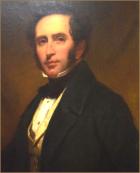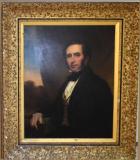By descent in the famiy
John was born about 1798, the 3rd son of Jefferys Allen and Susan Burlton, in Bridgwater, Somerset. He was admitted a pensioner at Pembroke College, Cambridge, on April 17, 1817, and matriculated at Michaelmas that year. He was a "scholar", he achived his B.A. in 1821 and his M.A. in 1825. On Jan. 17, 1821 he was admitted to the Inner Temple and called to the bar in 1826.; barrister-at-law until 1835; He would later be disbarred at his own request (nothing sinister, and not at all uncommon).
He and Lydia Augusta married by license of the Bishop of London. John Roy was then living in St George Hanover Square,and Lydia Augusta with her parents at Leamington, Warwickshire. It was a first marriage for both of them. Soon after the wedding John Roy started planning a grand house for himself in Taunton - Lyngford House; which he built in 1844 - it wasn't completed until 1846. In the meantime they lived in Wells, then moved to Gatchell House, Trull, Somerset, in the mid-1840s.
In 1844 John Roy's father died and the son was the executor of the huge estate, including Stocklinch Manor which the old man had acquired from Earl Poulett in 1823, along withe advowson of the parish church of Stocklinch Ottersay, as well as the manor house and grounds, and certain demesne lands, farms and hereditaments near Stocklinch (John Roy became entitled to all of this in 1848). John Roy came into a house at Lyme Regis, Dorset, 4,000 pounds and his father's books (and that was just in old Jefferys Allen's will. If a deceased was rich most of his assets never even got hinted at in the will).
John Roy was a JP, and recorder of Taunton, Andover and Bridgwater, 1841-61, and a Taunton Market trustee from 1850. He is mentioned in various histories of Somer. He died at Weston-super-Mare, 10 March 1875; his will was proved 26 April 1875 (estate under £18,000His will, drawn up on March 3, 1868, was proved on April 26, 1875.
There were houses all over the place. Lydia Augusta inherited his share in the houses and land at Stocklinch Ottersay and Stocklinch Magdalen, which he'd bought with one of his brothers (this was separate from the manor and advowson and all the rest of his inherited Stocklinch properties). She also got the land John Roy owned by himself - Ploughed Three Acres, Riddick's Mead and The Acre Piece - three parcels in Dunwear in the parish of Bridgwater. Lydia Augusta got all of this, all the money, and a lot more. She also received the annual sum of money from William Speke (a relative of John Hanning Speke, the African explorer), shared by John Roy's brothers Charles and William. After John Roy's death Lydia Augusta continued on at Lyngford House for a while, but by 1881 was staying with a grocer, John Saunders, at the prestigious 1 Edgar Buildings, Walcot, Bath, Somerset.
Children :
(1) Charles Jefferys Watson Allen (1832-93) of Lyngford House (q.v.);
(2) Rev. William Arthur Allen (1833-81), of Stocklinch Manor (q.v.);
(3) James Henry Allen (1834-1906) of Lyme Regis, born 7 March 1834; merchant; married, 29 January 1868, Sarah Barbara, daughter of William Morgan Benett of London, and had issue two sons and three daughters; died 8 August 1906; will proved 25 September 1906 (estate £23,818);
(4) Maj-Gen. John Edward Allen (1835-1909); born 23 August 1835; died unmarried, 27 July 1909; will proved 30 October 1909 (estate £83,233);
(5) Rev. Hunter Bird Allen (1837-1906), born 28 February 1837; educated at Oriel College, Oxford (matriculated 1855); ordained deacon, 1860 and priest, 1861; curate of Stanton Prior, c.1861-68; rector of Colmworth (Beds), 1868-1906; married, 1868, Adelaide Maria (1841-1938), daughter of Rev. John Gladstone, and had issue three sons; died 8 April 1906; will proved 27 June 1906 (estate £23,207);
(6) Etheldreda Augusta Allen (1839-96), born Jan-Mar 1839; married, 1 November 1864, as his second wife, Maj. Ralph S. Allen of Bathampton Manor (1817-87) and had issue five sons and four daughters; died 2 October 1896.6
Lyngford House is a picturesque and rather quirky two storey Tudor Gothic house, the entrance front with distinctive three-storey parapeted turrets set diagonally either side of a canted central porch. The south side has an off-centre broad canted bay, and the east side has a two-bay centre with a raised parapet for emphasis. The house was apparently built c.1844-46, although many elements of the design were distinctly old-fashioned by then. It is built of red sandstone rubble with Bath stone dressings, except for the broad canted bay on the south front, which is of brick. The whole house was no doubt rendered originally, although it had been stripped by 1908. Inside there is a central octagonal stairwell hall with a cantilevered stair and Tudor arch-headed recesses, but the remaining interiors have little of interest. The house has belonged to the local health authority for many years and is now run as a conference and wedding venue.
Descent: Built for John Roy Allen (1799-1875); to son, Charles Jefferys Watson Allen (1832-93); to son, Jefferys Philip Thomas Allen (1867-1917); sold after his death to Stephen Matthews (d. 1929); to widow, Mary Ann Matthews (d. 1937)...Somerset Area Health Authority
Clint, George (1770–1854), theatrical genre painter and engraver, was born in London at Brownlow Street, Holborn, on 12 April 1770, the son of Michael Clint, a hairdresser in Lombard Street, and his first wife. The family came from Hexham in Northumberland. Clint received a simple education in Yorkshire. He had several false starts before taking up painting, first as a fishmonger's apprentice, then in an attorney's office, and finally as a house-painter. During this period he married his first wife, the daughter of a small farmer in Berkshire, with whom he had five sons and four daughters. Clint began as a miniature painter with a painting room in Leadenhall Street, London. From Edward Bell, the nephew of John Bell the publisher, a mezzotint engraver best-known for his plates after George Morland, Clint learned the technique of mezzotint engraving that he practised throughout his career. Among his early engravings are The Frightened Horse after George Stubbs, and The Death of Nelson after W. Drummond. The precise date when Clint embarked on an artistic career is uncertain, but from the path of his development and the date of his first oil painting exhibited at the Royal Academy (1802) it can probably be assigned to the mid-1790s. From his wife's approach to Sir William Beechey for an opinion on his first attempt at oil painting, a portrait of his wife, a lasting friendship grew between Clint and Beechey. At about this time Clint's friend Samuel Reynolds, the mezzotint engraver, advised him to take up watercolour portraiture. Clint eked out his income by painting copies of prints after Morland and David Teniers, and many copies of The Enraged Bull and The Horse Struck by Lightning by Stubbs. Sir Thomas Lawrence was impressed by Clint's engraving skills and gave Clintseveral of his portraits to engrave. A misunderstanding over the engraving of Lawrence's portrait of Lord Ellenborough which Clint believed had been promised to him but which Lawrence disposed elsewhere led to a rupture in their relationship that damaged Clint's engraving practice.
A significant event in Clint's career was his engraving of G. H. Harlow's theatrical painting The Trial Scene from ‘Henry VIII’ with portraits of the Kemble family, published in January 1819. Harlow's picture was an attempt to raise the status of theatrical genre painting to that enjoyed by history painting. Clint's engraving of this work established his reputation for treating theatrical subjects. Clint practised as a portrait painter throughout his career, but is chiefly remembered for his theatrical scene paintings. He also painted numerous theatrical portraits. His principal patrons were Lord Egremontand the celebrated actor Charles Mathews the elder. Between 1802 and 1817 the Royal Academy catalogues show that he frequently changed his studio address (all in London), suggesting that his commissions during this period were haphazard and uncertain. From 1817 he remained for over twenty years at 83 Gower Street, London. Throughout the 1820s he exhibited at the Royal Academy a number of theatrical scenes with portraiture from a scene in The Clandestine Marriage (1819) to a scene from Love, Law and Physic (1830; both Garrick Club, London). The most ambitious of these works is his large painting of Edmund Kean in A New Way to Pay Old Debts (1820; Garrick Club), which approaches the scale of a history painting, but he did nothing else in the same vein. His works of this period generally derive from ephemeral comedies and farce. Clint was elected an associate of the Royal Academy in 1821 presumably on the strength of his scene from Lock and Key (Garrick Club), exhibited in the same year.
In the 1830s Clint's theatrical scenes changed to subjects from Shakespearian comedy painted without portraiture and so distanced from the working stage. Typical of those scenes are the three works painted for Lord Egremont exhibited at the Royal Academy in 1833: The Carousing Scene and The Duelling Scene from Twelfth Night, and Falstaff Relating his Gadshill Adventure from 1 Henry IV (Petworth House, Sussex). This change of style was not to a purely literary representation of dramatic subjects since the spatial and compositional restrictions of the stage remained. Clint was a painter of the comic. His only scene from tragedy was from the working stage: Mr. Young in ‘Hamlet’ (V&A), shown at the Royal Academy in 1831. In his colouring Clint was influenced by the work of seventeenth-century Netherlandish masters, including Van Dyck. The largest collection of Clint's theatrical works is in the Garrick Club, London, which owns six of his scene paintings and ten theatrical portraits.
Full membership of the Royal Academy was an important goal for Clint. His failure to achieve this led to his resignation from the academy in 1836. In that year he gave evidence hostile to the Royal Academy to the House of Commons select committee on arts and manufactures. He seems to have had a difficult temperament. While he was not directly involved in current debates on the direction and content of the visual and dramatic arts, Clint's work stands at the intersection of painting and the theatre and is emblematic of those debates.
The poverty Clint knew for most of his life was eased by some property that came to him with his second wife, which helped to augment his income from painting and engraving. He retired to 1 Albert Cottages, Montpellier Road, Peckham, Surrey, and moved near the end of his life to 32 Pembroke Square, Kensington, where he died, a widower, on 16 May 1854. He was buried in Kensal Green cemetery. Clint had a pupil, (Robert) William Buss, who was the author of his obituary in the Art Journal (July 1854). Of his sons, Scipio Clint (1805–1839) became a medallist, and Alfred Clint (1807–1883)became a marine painter.
- A. Nisbet DNB



